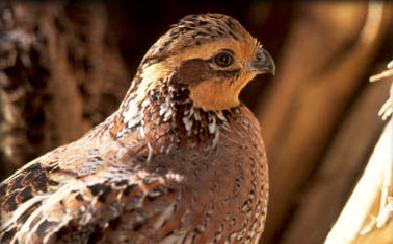Quail - Bobwhite
Bobwhite Scientific Name: Colinus virginianus
Thu, 3rd July, 2025 - 8:36 am GMT
Sponsor Ads:

Alternative Name
Bobwhite Scientific Name: Colinus virginianusBasic Info
At maturity, a Bobwhite Quail usually measures about ten inches in length. Predominantly, the Bobwhite Quail is a rusty brown color, although its underside may be lighter brown. Often there is gray coloration over the back of the quail. A male Bobwhite Quail has a white throat with a line above each eye. These white lines are striped back to the neck from the eye. Female Bobwhite Quails have the same patterns, but their throats are a light tan color, as are their eye lines.
Health
In order to preserve the Bobwhite Quail, a few preservation techniques have been suggested. One of these involves the leaving of small patches of grain along edge areas in the winter. Habitats may also be created for the Bobwhite Quail by planting woody undergrowth or bramble areas where the quail may shelter. Breeding The Mating season for Bobwhite Quail occurs in the spring and will often last into September. Generally, the males will perform mock combats in order to display for their mates. The male usually scrapes out a depression in old grass to use as the nest. Generally, the eggs require about 23 days to incubate. An average clutch contains about 14 eggs. Usually nesting occurs between June and September. Bobwhite Quail chicks are tiny- about the size of bumblebees! They rely on their parents for food and for warnings of danger. When the chicks are about five weeks old, they will begin to obtain food independently of the parents.Habitat
N/ABehavior
The Bobwhite Quail, unlike many animals, actually benefited from early settling of its range when settlers built protected fenced areas and fields of grain over the quail's range! Before the mating season in begins, Bobwhite Quail live in coveys of about six birds. However, this number may fluctuate between ten and thirty birds. The coveys begin to break up around March as males compete with each other for the females. After the breeding season ends in the fall, coveys are reformed. Usually there is a social order in such coveys, and the Bobwhite Quail remain close together and tend to move and sleep as a single unit. When startled, however, the Bobwhite Quail scatter in all directions. Usually the covey spends the day in search of food, resting during the hottest hours of the day. Bobwhite Quail prefer to live in edge-lands, where one type of habitat meets another. Generally, this may be the border between a wooded area and a grassy expanse.Origin
United StatesHistory
Bobwhite Quail began to flourish with the early settling of the Americas, but the trend will not continue if humans continue to destroy the natural habitat of these birds! Their numbers are also often checked by harsh winter conditions. Bobwhite Quail are generally seen in the wild in the Midwest and Southern United States as well as parts of Mexico. As game birds, they were often trapped rather than hunted. Today, hunters with dogs usually hunt Bobwhite Quail. Enthusiasts, scientists, and photographers also love finding and observing these birds in their natural habitats. The Bobwhite Quail receives its name from the male's mating call, which sounds like the syllables "Ah-bob-white".Common Foods
Bobwhite Quail feed on seeds, insects and vegetation. Their diet may include berries, corn, soybeans, grasses and clover, in addition to insects and seeds, which they obtain by scratching at the ground.Sponsor Ads:
"In the practical art of war, the best thing of all is to take the enemy's country whole and intact; to shatter and destroy it is not so good. So, too, it is better to recapture an army entire than to destroy it, to capture a regiment, a detachment or a company entire than to destroy them." -- Sun Tzu, The Art of War
Quail - Bobwhite
Coded by: BGID® | ALL RIGHTS RESERVED Copyright © 2000-2025
Disclaimer | Privacy | Report Errors / Contact | Credits

 Why haven't we as a collective earth met with aliens yet?
Why haven't we as a collective earth met with aliens yet?  World EcoSystem - Biodiversity Changes - Who is on board and who isn
World EcoSystem - Biodiversity Changes - Who is on board and who isn  Homosexual behavior stems from the mind or genetics?
Homosexual behavior stems from the mind or genetics?  The Best Text Adventure You Will Ever Play! The official site:
The Best Text Adventure You Will Ever Play! The official site:  Mouthwash - Mouthrinse - Mouth Sores - Healing Infections - Gingivitis
Mouthwash - Mouthrinse - Mouth Sores - Healing Infections - Gingivitis  Treatment for Depression
Treatment for Depression  Ultra radical and violent Islamist group that even rivals Al Qaeda
Ultra radical and violent Islamist group that even rivals Al Qaeda  An idea to have teachers who want to carry guns to school undergo some level of police training will be left up to local school districts and police departments.
An idea to have teachers who want to carry guns to school undergo some level of police training will be left up to local school districts and police departments.